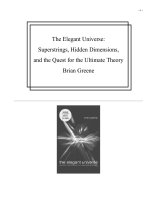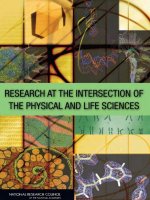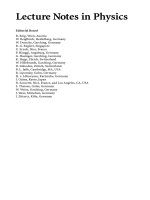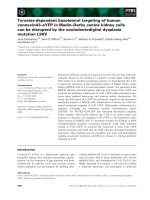- Trang chủ >>
- Khoa Học Tự Nhiên >>
- Vật lý
how can the human mind occur in the physical universe aug 2007
Bạn đang xem bản rút gọn của tài liệu. Xem và tải ngay bản đầy đủ của tài liệu tại đây (4.02 MB, 301 trang )
How Can the Human Mind
Occur in the Physical Universe?
OXFORD SERIES ON
COGNITIVE MODELS AND ARCHITECTURES
Series Editor
Frank E. Ritter
Series Board
Rich Carlson
Gary Cottrell
Pat Langley
Richard M. Young
Integrated Models of Cognitive Systems
Edited by Wayne D. Gray
In Order to Learn:
How the Sequence of Topics Infl uences Learning
Edited by Frank E. Ritter, Josef Nerb,
Erno Lehtinen, and Timothy M. O’Shea
How Can the Human Mind Occur
in the Physical Universe?
By John R. Anderson
How Can the Human Mind
Occur in the
Physical Universe?
John R. Anderson
2007
Oxford University Press, Inc., publishes works that further
Oxford University’s objective of excellence
in research, scholarship, and education.
Oxford New York
Auckland Cape Town Dar es Salaam Hong Kong Karachi
Kuala Lumpur Madrid Melbourne Mexico City Nairobi
New Delhi Shanghai Taipei Toronto
With offices in
Argentina Austria Brazil Chile Czech Republic France Greece
Guatemala Hungary Italy Japan Poland Portugal Singapore
South Korea Switzerland Thailand Turkey Ukraine Vietnam
Copyright © 2007 by John R. Anderson
Published by Oxford University Press, Inc.
198 Madison Avenue, New York, New York 10016
www.oup.com
Oxford is a registered trademark of Oxford University Press
All rights reserved. No part of this publication may be reproduced,
stored in a retrieval system, or transmitted, in any form or by any means,
electronic, mechanical, photocopying, recording, or otherwise,
without the prior permission of Oxford University Press.
Library of Congress Cataloging-in-Publication Data
Anderson, John R. (John Robert), 1947–
How can the human mind occur in the physical universe? / John R. Anderson.
p. cm. — (Oxford series on cognitive models and architectures ; 3)
Includes bibliographical references and index.
ISBN 978-0-19-532425-9
1. Cognition. 2. Newell, Allen. I. Title.
BF311.A5897 2007
153—dc22 2007003533
1 3 5 7 9 8 6 4 2
Printed in the United States of America
on acid-free paper
In memory of Allen Newell and Herbert Simon,
who made so much possible for so many
This page intentionally left blank
Preface
I set out to write this book as a modern statement of the ACT-R theory
and to show how it relates to what we know about the human brain.
I wanted this to be a succinct and accessible statement that got at the es-
sence of the matter. Early on, struggling with these goals, I was drawn to
the last lecture of Allen Newell by my memories of a few minutes from
that lecture that were particularly inspiring for me. I found the recording
of this lecture and reaffirmed my memories of those minutes. The first
chapter discusses what Newell said during those few minutes. However,
I listened to the whole lecture, and I would recommend that everyone
who aspires to contribute to cognitive science do the same. The spirit of
that lecture has managed to guide me through this book, and the book
has become more than just a succinct and accessible recounting of the
ACT-R theory. Constantly having Newell’s voice in the back of my mind
has helped me focus, not on ACT-R, but rather on what Newell identified
as one of the ultimate questions of science. This is the title of the book.
At times I shift from this central question to the supporting details that
Newell loved, but I hope the reader will be able to come away from this
book with the sense that we are beginning to understand how the human
mind can occur in the physical world.
Many individuals have helped me in various ways in the writing of this
book. At the highest level, this book ref lects the work of the whole field,
the countless conversations I have had with many cognitive scientists, and
the many papers I have read. Much of what the book reports are contri-
butions of members of the ACT-R community. My own research group
at Carnegie Mellon University has heard me talk about these ideas many
times and has given me feedback at many levels. In September 2006
I gave a series of five Heineken Lectures
1
in the Netherlands to different
groups based on the five major chapters of this book. Their feedback was
valuable and did much to complete my image for the book. My colleague
Niels Taatgen, in addition to all of his intellectual contributions, contrib-
uted the cover of the book, which was the art piece chosen by Heineken
Award committee.
The book also ref lects the products of the generous funding of science,
particularly in the United States. Different aspects of my own research
described in this book have been funded at different times by DARPA,
ONR, NASA, NIE, NIMH, and NSF.
2
The long-standing and steady sup-
port for the development of ACT-R has come from ONR. Susan Chip-
man, who ran the Cognitive Science program there for many years, has
done so much to support the establishment of a firm theoretical founda-
tion for our field.
Many people read the complete book and gave me blunt feedback
on its content: Erik Altmann, Stuart Card, Jonathan Cohen, Stanislas
Dehaene, Gary Marcus, Alex Petrov, Frank Ritter, and Josh Tenenbaum.
A number of people have commented on specific chapters: Scott Dou-
glass, Jon Fincham, Wayne Gray, Joshua Gross, Yvonne Kao, Sue Kase,
Jong Kim, Christian Lebiere, Rick Lewis, Julian Pine, Lynne Reder, Lael
Schooler, and Andrea Stocco. Catharine Carlin at Oxford University
Press has been a great editor, dealing with all my concerns about creating
a contract that would enable maximal dissemination of the ideas, arrang-
ing for many of these reviews, and shepherding the book through the
publication process. Nicholas Liu, also at Oxford, has also been of great
help, particularly in the later stages of getting this book out. Last but
not least, I thank my research associate Jennifer Ferris, who has read the
book over many times, kept track of figures and permissions, and man-
aged the references and the many other things that are needed in getting
this book out.
1. I received the first Heineken Award in Cognitive Science in 2006. This was really
given in recognition of the work done by everyone in the ACT-R community.
2. For those for whom these American acronyms are not just common words: Defense
Advanced Research Projects Agency, Office of Naval Research, National Aeronautics
and Space Administration, National Institute of Education, National Institute of Mental
Health, and National Science Foundation.
viii Preface
ix
Contents
1. Cognitive Architecture 3
2. The Modular Organization of the Mind 45
3. Human Associative Memory 91
4. The Adaptive Control of Thought 135
5. What Does It Take to Be Human? Lessons From High
School Algebra 187
6. How Can the Human Mind Occur? 237
References 249
Author Index 275
Subject Index 283
This page intentionally left blank
How Can the Human Mind
Occur in the Physical Universe?
This page intentionally left blank
3
1
Cognitive Architecture
Newell’s Ultimate Scientifi c Question
On December 4, 1991, Allen Newell delivered his last lecture, knowing
that he was dying. Fortunately, it was recorded.
1
I recommend it to any-
one who wants to hear a great scientist explaining the simple but deep
truths about his life as a scientist. For different people, different gems
stand out from that talk, but the thing that stuck with me was his state-
ment of the question that drove him. He set the context:
You need to realize, if you haven’t before, that there is this col-
lection of ultimate scientific questions, and if you are lucky to get
grabbed by one of these, that will just do you for the rest of your
life. Why does the universe exist? When did it start? What’s the
nature of life? All of these are questions of a depth about the na-
ture of our universe that they can hold you for an entire life and
you are just a little ways into them.
Within this context, he announced that he had been so blessed by such a
scientific question:
The question for me is, how can the human mind occur in the
physical universe? We now know that the world is governed by
1. The portion of the lecture in question is available at our website: act-r.psy.cmu.edu.
The entire lecture is available in video form (Newell, 1993) and at wean1.ulib.org/cgi-bin/
meta-vid.pl?target=Lectures/Distinguished%20Lectures/1991.
4 How Can the Human Mind Occur in the Physical Universe?
physics. We now understand the way biology nestles comfortably
within that. The issue is, how will the mind do that as well? The
answer must have the details. I have got to know how the gears
clank and how the pistons go and all the rest of that detail. My
question leads me down to worry about the architecture.
When I heard these remarks from Newell, I heard what drove me
as a cognitive scientist stated more clearly than I had ever been able to
articulate it myself. As Newell said, this question can hold you for a life-
time, and you can only progress a little way toward the answer, but it is a
fabulous journey. While Newell spent much in his lifetime making prog-
ress on the answer, I think he would be surprised by the developments
since his death. For instance, we are now in a position where biology can
really begin to inform our understanding of the mind. I can just see that
enormous smile consuming his face if he had learned about the details of
these developments. The purpose of this book is to report on some of the
progress that has come from taking a variety of perspectives, including
the biological.
Although Newell did not come up with a final answer to his question,
he was at the center of developing an understanding of what that answer
would be like: It would be a specification of a cognitive architecture—“how
the gears clank and how the pistons go and all the rest of that detail.” The
idea of a cognitive architecture did not exist when Newell entered the
field, but it was well appreciated by the time he died. Because Newell did
more than anyone else to develop it, it is really his idea. It constitutes a
great idea of science commensurate to the ultimate question of science
that it addresses.
The purpose of this chapter is to describe what a cognitive architec-
ture is, how the idea came to be, and what the (failed) alternatives are,
and to introduce the cognitive architecture around which the discussions
in chapters 2–6 are organized.
What Is a Cognitive Architecture?
“Cognitive architecture” is a term used with some frequency in modern
cognitive science—it is one of the official topics in the journal Cognitive
Science—but that does not mean that what it implies is obvious to every-
one. Newell introduced the term “cognitive architecture” into cognitive
science through an analogy to computer architecture (Bell and Newell,
Cognitive Architecture 5
1971), which Fred Brooks (1962) introduced into computer science
through an analogy to the architecture of buildings.
2
When acting in his or her craft, the architect neither builds nor lives
in the house, but rather is concerned with how the structure (the domain
of the builder) achieves the function (the domain of the dweller). Archi-
tecture is the art of specifying the structure of the building at a level of
abstraction sufficient to assure that the builder will achieve the functions
desired by the user. As indicated by Brooks’s remarks at the beginning of
his chapter “Architectural Philosophy” in Planning a Computer System,
this seems to be the idea that he had in mind: “Computer architecture,
like other architecture, is the art of determining the needs of the user of a
structure and then designing to meet those needs as effectively as possible
within economic and technological constraints” (p. 5).
In this passage, Brooks is using “architecture” to mean the activity of
design; when people use “architecture” this is usually what they mean.
However, computer architecture has come to mean the product of the
design rather than the activity of design. This was the way Bell and Newell
used it and, as can be seen in his 1990 definition, this is also the meaning
Newell used when he referred to the “cognitive architecture”: “The fixed
(or slowly varying) structure that forms the framework for the immediate
processes of cognitive performance and learning” (p. 111).
3
This conception of cognitive architecture is found in a number of other
definitions in the field: “The functional architecture includes the basic op-
erations provided by the biological substrate, say, for storing and retrieving
symbols, comparing them, treating them differently” (Pylyshyn, 1984, p. 30).
Or my own rather meager definition: “A theory of the basic principles of
operation built into the cognitive system”
4
(Anderson, 1983, p. ix).
2. Brooks managed the development of the IBM 360, which at the time was a revolu-
tion in the computer world. His perspective on computer architecture came from his
experiences at IBM leading up to and including this development.
3. Elsewhere, reflecting the history that led to this definition, Newell describes cogni-
tive architecture as follows:
What is fixed mechanism (hardware) and what is content (software) at the symbol
level is described by the description of the system at the register-transfer level. . . .
To state the matter in general: given a symbol level, the architecture is the descrip-
tion of the system in whatever system-description scheme exists next below the
symbol level. (Newell, 1990, p. 81)
4. Although my quoted definition predates the Newell definition, I know I got the
term from discussions with him.
6 How Can the Human Mind Occur in the Physical Universe?
It is worth reflecting on the relationship between the original sense
of architecture involving buildings and this sense involving cognition.
Figure 1.1 illustrates that relationship. Both senses of architecture involve
relating a structure to a function:
Structure: The building’s structure involves its physical compon-
ents —its posts, fixtures, and so on. None of the above defi-
nitions of cognitive architecture actually mentions its physical
component—the brain—although Pylyshyn’s hints at it. While it
would be strange to talk about a building’s architecture at such a
level of abstraction that one ignores its physical reality—the build-
ing itself —one frequently finds discussions of cognitive architec-
ture that simply do not mention the brain. The definition at the
end of this section, however, makes explicit reference to the brain.
Function: The function of building architecture is to enable the
habitation, and the function of cognitive architectures is to en-
able cognition. Both habitation and cognition are behaviors of
beings, but there is a difference in how they relate to their given
structures. In the case of a building, its function involves another
agent: the dweller. In the case of a cognitive architecture (or
computer architecture), the structure is the agent.
5
Thus, there
is a functional shift from construction being designed to enable
Figure 1.1. An illustration of the analogy between physical architecture and
cognitive architecture. (Thanks to Andrea Stocco.)
5. One could get Platonic here and argue that “knowledge” is the agent occupying the
cognitive architecture; then the analogy to physical architecture would be even closer.
Cognitive Architecture 7
the activity of another to construction enabling its own activity.
Except for this shift, however, there is still the same structure–
function relationship: the function of the structure is to enable
the behavior. In both cases, an important measure of function is
the success of the resulting behavior—building architecture is
constrained to achieve successful habitation; cognitive architec-
ture is constrained to achieve successful cognition.
6
Before the idea of cognitive architecture emerged, a scientist interested
in cognition seemed to have two options: Either focus on structure and get
lost in the endless details of the human brain (a structure of approximately
100 billion neurons), or focus on function and get lost in the endless details
of human behavior. To understand the mind, we need an abstraction that
gets at its essence. The cognitive architecture movement reflects the real-
ization that this abstraction lies in understanding the relationship between
structure and function rather than focusing on either individually. Of course,
just stating the category of the answer in this way does not give the answer.
Moreover, everyone does not agree on which type of abstraction will pro-
vide the best answers. There are major debates in cognitive science about
what the best abstractions are for specifying a cognitive architecture.
With all this in mind, here is a definition of cognitive architecture for
the purposes of this book:
A cognitive architecture is a specification of the structure of the
brain at a level of abstraction that explains how it achieves the
function of the mind.
Like any definition, this one relates one term, in this case cognitive archi-
tecture, to other terms. I suspect readers are going to wonder more about
what the term “function of the mind” means in this definition than what
the term “structure of the brain” means. The goal of a cognitive architec-
ture is to provide the explanatory structure for better understanding both
of these terms. However, before specifying such an architecture—and as
some protection against misunderstanding—I note here that the “func-
tion of the mind” can be roughly interpreted as referring to human cogni-
tion in all of its complexity.
6. However, in one case the constraint is created by the marketplace and in the other
case by evolution. I am aware that this discussion ignores aesthetic issues that influence
the architecture of buildings.
8 How Can the Human Mind Occur in the Physical Universe?
Alternatives to Cognitive Architectures
The type of architectural program that I have in mind requires paying
attention to three things: brain, mind (functional cognition), and the ar-
chitectural abstractions that link them. The history of cognitive science
since the cognitive revolution has seen a number of approaches that tried
to get by with less; and so they can be viewed as shortcuts to under-
standing. This chapter examines three of the more prominent instances
of such shortcuts, discusses what they can accomplish, and notes where
they fall short of being able to answer Newell’s question. By looking at
these shortcuts and what their problems are, we can better appreciate
what the cognitive architecture program contributes when it attends to
all three components.
Shortcut 1. Classic Information-Processing Psychology:
Ignore the Brain
The first shortcut is the classic information-processing psychology that
ignored the brain.
7
It was strongly associated with Allen Newell and Her-
bert Simon, and one can argue that Newell never fully appreciated the
importance of the brain in an architectural specification. In the decades
immediately after cognitive psychology broke off from behaviorism, many
argued that a successful cognitive theory should be at a level of abstrac-
tion that ignored the brain. Rather than cite someone else for this bias,
I will quote myself, although I was just parroting the standard party line:
Why not simply inspect people’s brains and determine what goes
on there when they are solving mathematics problems? Serious
technical obstacles must be overcome, however, before the physi-
ological basis of behavior could be studied in this way. But, even
assuming that these obstacles could be properly handled, the level
of analysis is simply too detailed to be useful. The brain is com-
posed of more than 10 billion nerve cells.
8
Millions are involved
7. The modifier “classic” is appended because “information processing” is used in many
different senses in the field, and I do not want this characterization to seem to apply to
all senses of the term.
8. This number has also experienced some revision.
Cognitive Architecture 9
in solving a mathematics problem. Suppose we had a listing that
explained the role of each cell in solving the problem. Since the
listing would have to describe the behavior of individual cells, it
would not offer a very satisfactory explanation for how the prob-
lem was solved. A neural explanation is too complex and detailed
to adequately describe sophisticated human behavior. We need a
level of analysis that is more abstract. (Anderson, 1980, pp. 10–11)
The problem with this classic information-processing account is that
it is like a specification of a building’s architecture that ignores what the
building is made of. Nonetheless, this type of account was very successful
during the 1960s and 1970s. For example, the Sternberg task, and Saul
Sternberg’s (1966) model of it, were held up to my generation of gradu-
ate students as the prototype of a successful information-processing ap-
proach. In the prototypical Sternberg paradigm, participants are shown
a small number of digits, such as “3 9 7,” that they must keep in mind.
They are then asked to answer—as quickly as they can—whether a par-
ticular probe digit is in this memory set. Sternberg varied the number of
digits in the memory set and looked at the speed with which participants
could make this judgment. Figure 1.2a illustrates his results. He found
a nearly linear relationship between the size of the memory set and the
judgment time, with each additional item adding 35–40 ms to the time.
Sternberg also developed a very influential model of how participants
make these judgments that exemplifies what an abstract information-
processing model is like. Sternberg assumed that when participants saw
a probe stimulus such as a 9, they went through the series of information-
processing stages that are illustrated in figure 1.2b. The stimulus first has
to be encoded and then compared to each digit in the memory set. He
assumed that it took 35–40 ms to complete each of these comparisons.
Sternberg was able to show that this model accounted for the millisecond
behavior of participants under a variety of manipulations. Like many of
those who created the early information-processing theories, Sternberg
reached for the computer metaphor to help motivate his theory: “When
the scanner is being operated by the central processor it delivers memory
representations to the comparator. If and when a match occurs a signal is
delivered to the match register” (Sternberg, 1966, p. 444).
From its inception, there were expressions of discontent with the clas-
sic information-processing doctrine. With respect to the Sternberg model
itself, James Anderson wrote a 1973 Psychological Review article protesting
10 How Can the Human Mind Occur in the Physical Universe?
that this model was biologically implausible in assuming that compari-
sons could be completed in 35 ms. It became increasingly apparent that
the computer-inspired model of discrete serial search failed to capture
many nuances of the data (e.g., Glass, 1984; Van Zandt and Townsend,
1993). Such criticisms, however, were largely ignored until connectionism
arose in the 1980s. Connectionism’s proponents added many examples
bolstering Anderson’s general claim that processing in the brain is very
different from processing in the typical computer. The connectionists ar-
gued that processing was different in brains and computers because a
brain consists of millions of units operating in parallel, but slowly, whereas
the typical computer rapidly executes a sequence of actions, and because
computers are discrete in their actions whereas neurons in the brain are
continuous. The early connectionist successes, such as the Rumelhart and
Figure 1.2. (a) The results from a Sternberg experiment and the predictions
of the model; (b) Sternberg’s analysis of the sequence of information-
processing stages in his task that generate the predictions in (a). From
Sternberg (1969). Reprinted by permission of the publisher. Copyright
by American Scientist.
Cognitive Architecture 11
McClelland (1986) past-tense model, which is described below, illustrated
how much insight could be gained from taking brain processing seriously.
The rise of neural imaging in the 1990s has further showed the impor-
tance of understanding the brain as the structure underlying cognition. Ini-
tially, researchers were simply fascinated by their newfound ability to see
where cognition played out in the brain. More recently, however, brain-
imaging research has strongly influenced theories of cognitive architecture.
In this book I describe a number of examples of this influence. It has become
increasingly apparent that cognition is not so abstract that our understanding
of it can be totally divorced from our understanding of its physical reality.
Shortcut 2. Eliminative Connectionism: Ignore the Mind
As noted above, one reason for dissatisfaction with the information-
processing approach was the rise of connectionism and its success in ac-
counting for human cognition by paying attention to the brain. Eliminative
connectionism
9
is a type of connectionism that holds that all we have to do
is pay attention to the brain—just describe what is happening in the brain
at some level of abstraction. This approach ignores mental function as a
constraint and just provides an abstract characterization of brain structure.
Of course, that brain structure will generate the behavior of humans, and
that behavior is functional. However, maybe it is just enough to describe
the brain and get functional behavior for free from that description.
Eliminative connectionism is like claiming that we can understand a
house just in terms of boards and bricks without understanding the func-
tion of these parts. Other metaphors reinforce skepticism, for example,
trying to understand what a computer is doing solely in terms of the
activity of its circuitry without trying to understand the program that the
circuitry is implementing, or indeed, trying to understand the other parts
of the body just in terms of the properties of their cells without trying to
understand their function. Despite the reasons for skepticism, this is just
the approach of eliminative connectionism and it has had its successes. Its
goal is to come up with an abstract description of the computational prop-
erties of the brain—so-called “neurally inspired” computation—and then
9. This term was introduced by Pinker and Prince (1988) to describe connectionist
efforts that eliminate symbols as useful explanations of cognitive processes, although here
I am really using it to refer to efforts that ignore functional organization (how the pieces
are put together).
12 How Can the Human Mind Occur in the Physical Universe?
use this description to explain various behavioral phenomena. Eliminative
connectionism is not concerned with how the system might be organized
to achieve functional cognition. Rather, it assumes that cognition is what-
ever emerges from the brain’s responses to the tasks it is presented and
that any functionality comes for free—the house is what results from the
boards and the carpenters, and if we can live in it, so much the better.
Eliminative connectionism has enjoyed many notable successes over
the past two decades. The past-tense model of Rumelhart and McClelland
(1986) is one such success; I describe it here as an exemplary case. Children
show an interesting history in dealing with irregular past tenses (R. Brown,
1973). For instance, the past tense of “sing” is “sang.” First, children will use
the irregular correctly, generating sang; then they will overgeneralize the
past-tense rule and generate “singed”; finally, they will get it right for good
and return to “sang.” The existence of this intermediate stage of overgener-
alization has been used to argue for the existence of rules, since it is argued
that the child could not have learned from direct experience to inflect
“sing” with “ed.” Rather, children must be overgeneralizing a rule that has
been learned. Until Rumelhart and McClelland, this was the conventional
wisdom (e.g., R. Brown, 1973), but it was a bit of a “just so story,” as no one
produced a running model that worked in this way.
10
Rumelhart and McClelland (1986) not only challenged the conventional
wisdom but also implemented a system that approximated the empirical
phenomena by simulating a neural network, illustrated in figure 1.3, that
learned the past tenses of verbs. Their model was trained with a set of 420
pairs of root verbs with their past tenses. One inputs the root form of a verb
(e.g., “kick,” “sing”) as an activated set of feature units in the first layer of
figure 1.3. After passing through a number of layers of association, the past-
tense form (e.g., “kicked,” “sang”) should appear as another activated set of
feature units. A simple neural learning system was used to learn the map-
ping between the feature representation of the root and the feature rep-
resentation of the past tense. Thus, their model might learn (momentarily,
incorrectly) that words beginning with “s” are associated with past tense
endings of “ed,” thus leading to the “singed” overgeneralization (but things
10. Actually, this statement is a bit ungenerous to me. I produced a simulation model
that embodied this conventional wisdom in Anderson (1983), but it was in no way put
into serious correspondence with the data. Although the subsequent past-tense models
are still deficient in various aspects of their empirical support, they do reflect a more seri-
ous attempt to ground the theories in empirical facts.
Cognitive Architecture 13
can be much more complex in such neural nets). The model mirrored the
standard developmental sequence of children: first generating correct irreg-
ulars, then overgeneralizing, and finally getting it right. It went through the
intermediate stage of generating past-tense forms such as “singed” because
of generalization from regular past-tense forms. With enough practice, the
model, in effect, memorized the past-tense forms and was not using gener-
alization. Rumelhart and McClelland (1986) concluded:
We have, we believe, provided a distinct alternative to the view
that children learn the rules of English past-tense formation in
any explicit sense. We have shown that a reasonable account of
the acquisition of past tense can be provided without recourse to
the notion of a “rule” as anything more than a description of the
language. We have shown that, for this case, there is no induction
problem. The child need not figure out what the rules are, nor
even that there are rules. (p. 267)
Thus, they claim to have achieved the function of a rule without ever
having to consider rules in their explanation. The argument is that one can
Figure 1.3. The Rumelhart and McClelland (1986) model for past-tense
genera tion. The phonological representation of the root is converted into
a distributed feature representation. This representation is converted into a
distributed feature representation of the past tense, which is then mapped
into a phon ological representation of the past tense. From Rumelhart, D. E.,
& McClelland, J. L. In Parallel Distributed Processing: Explorations in the Micro-
structure of Cognition, Volume 2: Psychological and Biological Models. Copyright
1986 by MIT Press.
14 How Can the Human Mind Occur in the Physical Universe?
understand function by just studying structure.
11
The rule-like function of
the past tense inflection just emerges from low-level neural computations
that were not particularly designed to achieve this function. This original
model is 20 years old and had shortcomings that were largely repaired by
more adequate models that have been developed since (e.g., Plunkett and
Juola, 1999; Plunkett and Marchman, 1993). Many of these later models
are still quite true to the spirit of the original. This is still an area of lively
debate, and chapter 4 describes our contribution to that debate.
The whole enterprise, however, rests on a sleight of hand. This is not
often noted, perhaps because many other models in cognitive science de-
pend on this same sleight of hand.
12
The sleight of hand becomes appar-
ent if we register what the model is actually doing: mapping activation
patterns onto activation patterns. It is not in fact engaged in anything re-
sembling human speech production. Viewed in a quite generous light, the
model is just a system that blurts out past tenses whenever it hears present
tenses, which is not a common human behavior. That is, the model does
not explain how, in a functioning system, the activation-input patterns get
there, or what happens to the output patterns to yield parts of coherent
speech. The same system could have been tasked with mapping past tenses
onto present tenses—which might be useful, but for a different function.
The model seems to work only because we are able to imagine how it
could serve a useful function in a larger system, or because we hook it
into a larger system that actually does something useful. In either case, the
functionality is not achieved by a connectionist system; it is achieved by
our generous imaginations or by an ancillary system we have provided. So,
basically in either case, we provide the function for the model, but we are
not there to provide the function for the child. The child’s mind must put
together the various pieces required for a functioning cognitive system.
The above criticism is not a criticism of connectionist modeling per se,
but rather a criticism of modeling efforts that ignore the overall architec-
ture and its function. Connectionism is more prone to this error because
its more fine-grained focus can lead to myopic approaches. Nonetheless,
11. “Structure” here refers to more than just the network of connections; it also in-
cludes the neural computations and learning mechanisms that operate on this network.
12. Our own ACT-R model of past tense (Taatgen and Anderson, 2002) is guilty of
the same sleight of hand. It is possible to build such ACT-R simulations that are not end-
to-end simulations but simply models of a step along the way. However, such fragmentary
models are becoming less common in the ACT-R community.









